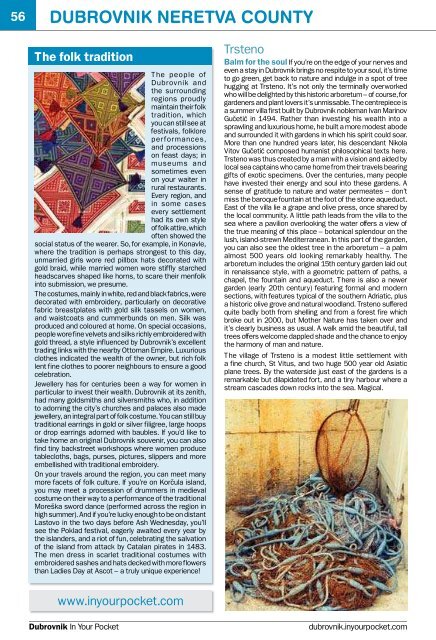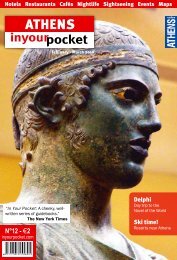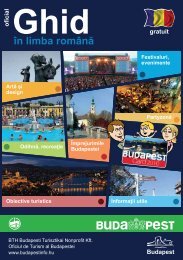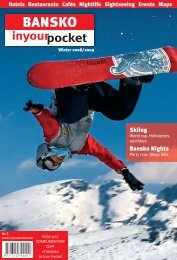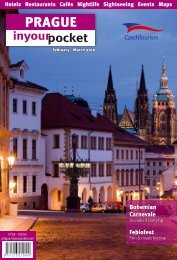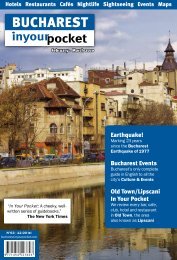DUBROVNIK - KISADO
DUBROVNIK - KISADO
DUBROVNIK - KISADO
You also want an ePaper? Increase the reach of your titles
YUMPU automatically turns print PDFs into web optimized ePapers that Google loves.
56 dubrovnik neretva county<br />
dubrovnik neretva county<br />
57<br />
The folk tradition<br />
Th e peopl e o f<br />
Dubrovnik and<br />
the surrounding<br />
regions proudly<br />
maintain their folk<br />
tradition, which<br />
you can still see at<br />
festivals, folklore<br />
per formances,<br />
and processions<br />
on feast days; in<br />
m u s e u m s a n d<br />
sometimes even<br />
on your waiter in<br />
rural restaurants.<br />
Every region, and<br />
in some cases<br />
every settlement<br />
had its own style<br />
of folk attire, which<br />
often showed the<br />
social status of the wearer. So, for example, in Konavle,<br />
where the tradition is perhaps strongest to this day,<br />
unmarried girls wore red pillbox hats decorated with<br />
gold braid, while married women wore stiffly starched<br />
headscarves shaped like horns, to scare their menfolk<br />
into submission, we presume.<br />
The costumes, mainly in white, red and black fabrics, were<br />
decorated with embroidery, particularly on decorative<br />
fabric breastplates with gold silk tassels on women,<br />
and waistcoats and cummerbunds on men. Silk was<br />
produced and coloured at home. On special occasions,<br />
people wore fine velvets and silks richly embroidered with<br />
gold thread, a style influenced by Dubrovnik’s excellent<br />
trading links with the nearby Ottoman Empire. Luxurious<br />
clothes indicated the wealth of the owner, but rich folk<br />
lent fine clothes to poorer neighbours to ensure a good<br />
celebration.<br />
Jewellery has for centuries been a way for women in<br />
particular to invest their wealth. Dubrovnik at its zenith,<br />
had many goldsmiths and silversmiths who, in addition<br />
to adorning the city’s churches and palaces also made<br />
jewellery, an integral part of folk costume. You can still buy<br />
traditional earrings in gold or silver filigree, large hoops<br />
or drop earrings adorned with baubles. If you’d like to<br />
take home an original Dubrovnik souvenir, you can also<br />
find tiny backstreet workshops where women produce<br />
tablecloths, bags, purses, pictures, slippers and more<br />
embellished with traditional embroidery.<br />
On your travels around the region, you can meet many<br />
more facets of folk culture. If you’re on Korčula island,<br />
you may meet a procession of drummers in medieval<br />
costume on their way to a performance of the traditional<br />
Moreška sword dance (performed across the region in<br />
high summer). And if you’re lucky enough to be on distant<br />
Lastovo in the two days before Ash Wednesday, you’ll<br />
see the Poklad festival, eagerly awaited every year by<br />
the islanders, and a riot of fun, celebrating the salvation<br />
of the island from attack by Catalan pirates in 1483.<br />
The men dress in scarlet traditional costumes with<br />
embroidered sashes and hats decked with more flowers<br />
than Ladies Day at Ascot – a truly unique experience!<br />
www.inyourpocket.com<br />
Trsteno<br />
Balm for the soul If you’re on the edge of your nerves and<br />
even a stay in Dubrovnik brings no respite to your soul, it’s time<br />
to go green, get back to nature and indulge in a spot of tree<br />
hugging at Trsteno. It’s not only the terminally overworked<br />
who will be delighted by this historic arboretum – of course, for<br />
gardeners and plant lovers it’s unmissable. The centrepiece is<br />
a summer villa first built by Dubrovnik nobleman Ivan Marinov<br />
Gučetić in 1494. Rather than investing his wealth into a<br />
sprawling and luxurious home, he built a more modest abode<br />
and surrounded it with gardens in which his spirit could soar.<br />
More than one hundred years later, his descendant Nikola<br />
Vitov Gučetić composed humanist philosophical texts here.<br />
Trsteno was thus created by a man with a vision and aided by<br />
local sea captains who came home from their travels bearing<br />
gifts of exotic specimens. Over the centuries, many people<br />
have invested their energy and soul into these gardens. A<br />
sense of gratitude to nature and water permeates – don’t<br />
miss the baroque fountain at the foot of the stone aqueduct.<br />
East of the villa lie a grape and olive press, once shared by<br />
the local community. A little path leads from the villa to the<br />
sea where a pavilion overlooking the water offers a view of<br />
the true meaning of this place – botanical splendour on the<br />
lush, island-strewn Mediterranean. In this part of the garden,<br />
you can also see the oldest tree in the arboretum – a palm<br />
almost 500 years old looking remarkably healthy. The<br />
arboretum includes the original 15th century garden laid out<br />
in renaissance style, with a geometric pattern of paths, a<br />
chapel, the fountain and aqueduct. There is also a newer<br />
garden (early 20th century) featuring formal and modern<br />
sections, with features typical of the southern Adriatic, plus<br />
a historic olive grove and natural woodland. Trsteno suffered<br />
quite badly both from shelling and from a forest fire which<br />
broke out in 2000, but Mother Nature has taken over and<br />
it’s clearly business as usual. A walk amid the beautiful, tall<br />
trees offers welcome dappled shade and the chance to enjoy<br />
the harmony of man and nature.<br />
The village of Trsteno is a modest little settlement with<br />
a fine church, St Vitus, and two huge 500 year old Asiatic<br />
plane trees. By the waterside just east of the gardens is a<br />
remarkable but dilapidated fort, and a tiny harbour where a<br />
stream cascades down rocks into the sea. Magical.<br />
Olive oil<br />
Olives have played a small but integral part in world history,<br />
yet nobody ever really notices this. Think about it, winners<br />
at the first Olympics were given an olive wreath to wear<br />
on their heads, we extend an olive branch as a sign of<br />
peace, and even Popeye’s lanky girlfriend was named<br />
Olive Oil. The signs are clear, if olives are good enough<br />
for athletic glory, peace, and a belligerent sailor, they’re<br />
good enough for all of us.<br />
By now we’ve all heard that olive oil is an integral part of<br />
the “Mediterranean diet” which medicine has associated<br />
with sensible portions and slower, more enjoyable<br />
eating. Studies have shown that those who partake in<br />
the “Mediterranean diet” to have a remarkable variety<br />
of health benefits. It’s even suggested that olive oil<br />
decreases the rate of cardiovascular disease and cancer.<br />
Rich in monounsaturated fatty acids, it helps lower<br />
dangerous blood cholesterol and is rich in vitamins and<br />
antioxidants. How about that? A combination of olive oil<br />
and a diet rich in vegetables and fish is healthy, delicious,<br />
and satisfying!<br />
The Adriatic coast has a centuries old tradition of olive<br />
harvesting and processing to reap the benefits of olive oil.<br />
From the northern coast to Dubrovnik and all the islands<br />
included, olive trees dot the landscape throughout the<br />
Croatian Adriatic. Olive oil today is still as important a<br />
part of the diet in Dalmatia as it always was. And in spite<br />
of some minor technological advances the process is<br />
more or less the same.<br />
Olives are picked from the end of October to the end of<br />
the Christmas period, and there are a few of methods of<br />
doing so. Some pickers hack away at branches, collecting<br />
the whole thing and plucking olives off one by one later.<br />
Other growers use a rake to bring down the olives, or<br />
a more painstaking route is to pick individual goodies<br />
Fun for the whole family<br />
dubrovnik.inyourpocket.com<br />
straight from the tree. The results are collected in a box<br />
called a Takalać, which the pickers later sift through to<br />
sort out the fruit from the twigs and leaves.<br />
After the harvest comes the pressing part. Literally. Back<br />
in the day, the olives would be pressed on a stone wheel<br />
turned either by hand or maybe beast of burden. The<br />
olives would be set on a mat and put under the wheel,<br />
squeezing them to a pulp as all the juicy goodness ran<br />
out of them. Today, most olives are no longer pressed<br />
by stone wheel, they’re drained using hydraulic presses.<br />
The rest of the process is really no different from the old<br />
school days. The first press yields the extra virgin oil, that<br />
is the oil of the highest quality, which must be made from<br />
green olives that are not too ripe. Subsequent pressing<br />
of the pulp will get you more olive oil, but the quality isn’t<br />
quite the same as the first.<br />
Some homes on<br />
the coast still use a<br />
stone basin to hold<br />
the oil, but usually<br />
it’s placed in bottles<br />
(glass is the best for<br />
the oil) and stored<br />
for the coming winter<br />
and summer. Once<br />
bottled, the oil has<br />
a lifespan of about 2<br />
years. A lot of locals<br />
in Dalmatia sell their<br />
oil to tourists, and<br />
it’s good stuff. The<br />
oil should have a<br />
greenish tint and<br />
strong aroma. A<br />
liter usually costs<br />
about 15 Euro, but<br />
haggling can’t hurt.<br />
Get there and buy some home made oil, all of you!<br />
This text has been created to acquaint the public with<br />
the olive growing tradition - it is not a scientific or expert<br />
text.<br />
Dubrovnik In Your Pocket<br />
dubrovnik.inyourpocket.com<br />
dubrovnik.inyourpocket.com<br />
Winter 2009 - Spring 2010


